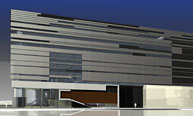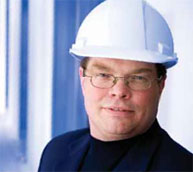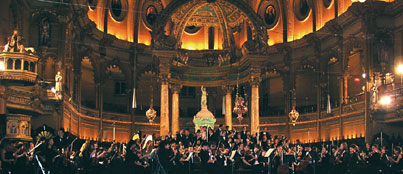In Tune with the Future: A New Dynamic for the Faculty of Music
In Tune with the Future: A New Dynamic for the Faculty of Music McGill University
User Tools (skip):
In Tune with the Future: A New Dynamic for the Faculty of Music

Above and below: An architect's rendering of the new music building and the proposed multimedia room.

There's a hot new vibe happening at Canada's top music school, one that will make McGill a world leader in a fascinating - and sometimes surprising - range of research.
Don McLean of the Faculty of Music might be the only expert in Schenkerian analysis - an infamously recondite method of distinguishing musical compositions from their background structures - who keeps a hard hat in his office. Sometimes the 50-year-old Toronto native seems less dean than general contractor as he talks about the new faculty building rising next door at the corner of Sherbrooke and Aylmer streets.
"The good news is that we not only replaced an aging chiller, we got an eighth floor," he says proudly of the alternative spot he found for an air conditioning unit. "It was originally a seven-floor design. Understandably, there are restrictions on height, 37 metres, in front of the mountain. With a chiller on the roof, there goes the eighth floor."
Now that top layer - of a building designed by Montreal architects Gilles Saucier and Anik Shooner to relate to the mountain by evoking horizontal geological strata - can accommodate the offices and research labs of the fledgling Centre for Interdisciplinary Research in Music Media and Technology.
Down in the basement, encased in two enormous soundproof concrete boxes, one inside the other, sits a four-storey room that McLean confidently says will be the finest facility in the world for sound recording and research. This Multimedia Room (MMR - to use one of a few names proposed for it) is what makes the gleaming new building a bold gamble rather than just an overdue expansion. McLean expects major movie scores to be made here. He wants Kent Nagano and the Montreal Symphony Orchestra to avail themselves of its many 21st-century attractions. And he plans to fill the building with world leaders in every branch of recording and acoustical research.

Dean of Music Don McLean in the new music building during the last phase of construction.
Claudio Calligaris
"It is the musical recording equivalent of a wind tunnel or particle accelerator," McLean says of the facility, choosing images that perfectly evoke the added scientific orientation of the faculty as he envisages it.
Necessity is in some respects the mother of all this invention. It was obvious a decade ago that the music school had split the seams of Royal Victoria College, the former women's residence it occupied in 1971. By the 1990s the Strathcona Music Building (as it was renamed) was not only too small, but also in sadly poor repair. The Quebec Ministry of Education gave the faculty $1 million in 1995 to prepare drawings for a new building - a gift that implied that more was on the way. Alas, nothing was on the way, at least not until the spring of 2001, when the province recalled its previous interest in the project and came up with $15 million to start the building in earnest.
Some features of the new structure fall under the rubric of garden-variety academia. Three floors are devoted to the Marvin Duchow Music Library, which for 13 years has occupied rental space in an office building across the street. Up-to-date and fully wired, the library will be visible at night through square windows on both the Sherbrooke and Aylmer facades, proclaiming the research vocation of the faculty. A 200-seat recital hall, visible in terra cotta profile on Aylmer, will say something about the stature of the performance department. Along with the Wirth Opera Rehearsal Room in the basement, this hall should take some pressure off redoubtable Pollack Hall, easily the busiest concert venue in the city. Meanwhile, two floors of administrative and staff offices will open space in the old east wing for badly needed classroom, studio and rehearsal space.
But the real story - and the reason the budget for the project has jumped from $24 million to $50 million - resides in the state-of-the-art MMR and its related research facilities. Designed by the world-leading acoustical firm Artec, which has in recent years worked on acclaimed concert halls in Dallas and Lucerne and brought back Toronto's Roy Thomson Hall from the dead, the big box can accommodate a symphony orchestra and chorus - which it will have to if it is used as a Hollywood-style sound studio, as McLean expects it to be. Its excellent natural acoustical properties will be complemented in the adjacent control rooms by technological accoutrements of the highest calibre.
McGill is both an ideal and an unlikely place for this thrust into the realm of acoustic research and recording technology. A fair case could be made for conservatism and consolidation, since the faculty already does many things very well. Opened in 1904 as the McGill Conservatorium, the institution achieved faculty status in 1920 and was reorganized into theoretical and practical departments in 1955.
The architect of the comprehensive music school we know today was the late Helmut Blume, a German refugee who disregarded (or interpreted creatively) the suggestion that he downgrade the faculty into an arts department when he was named dean in 1964. The faculty then had 40 students. It now has 820, making it the largest and probably the best in the country.
With a vigorous early-music program and an acclaimed jazz band, the school calmly covers the Renaissance to the present in its performance department. Composition professor Denys Bouliane has lifted McGill's Contemporary Music Ensemble to the elite level of its professional partner ensemble from the Société de musique contemporaine du Québec and created the in-house MusiMars Festival and its biennial international alternate, the Festival Montréal-Nouvelles-Musiques. The Electronic Music Studio, one of the first such laboratories in Canada, has been renamed the Digital Composition Studio to accommodate the 21st-century post-analog reality, while the classic tracker organ in Redpath Hall continues to recreate 18th-century France perhaps more elegantly than any such replica on the continent.

The McGill Symphony Orchestra performs Mahler's 2nd Symphony at Église St. Jean-Baptiste in Montreal.


